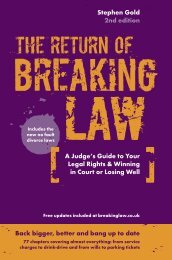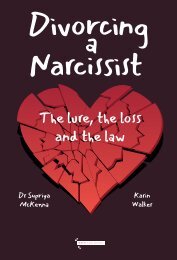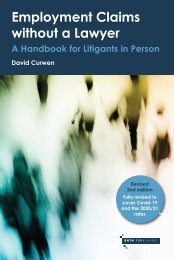Insolvency Made Clear: A Guide for Debtors
Plain English, practical guidance for anyone facing demands over a debt they are struggling to pay.
Plain English, practical guidance for anyone facing demands over a debt they are struggling to pay.
You also want an ePaper? Increase the reach of your titles
YUMPU automatically turns print PDFs into web optimized ePapers that Google loves.
Effect Of Bankruptcy<br />
the seller goes to the first car dealership they know about. Transactions at<br />
an undervalue are usually only identified in extreme cases, where the best<br />
explanation <strong>for</strong> why the item was sold at that value is the desire <strong>for</strong> the<br />
purchaser to make a profit at the expense of the soon-to-be bankrupt. This<br />
desire is not a requirement of a s339 transaction.<br />
2. Preferences: s340 of the Act. Where a bankrupt has ‘at a relevant time’<br />
given a preference to any person, the Trustee can apply <strong>for</strong> an order <strong>for</strong> the<br />
court to restore the position to what it would have been had the individual<br />
not given that preference. A ‘preference’ is given where one creditor (or a<br />
guarantor of the bankrupt’s debts) is deliberately put in the position where<br />
they are better off. It will be assumed that the preference was deliberately<br />
given if it was received by an ‘associate’ of the bankrupt. Outside of an associate,<br />
it is often difficult <strong>for</strong> a Trustee to show that a preference was given<br />
with the wrong intention. An example of a preference is when a bankrupt<br />
repays her parents’ loan in full. Even though the money was owed to the<br />
parents, the parents would be in a better position than had they received<br />
the same treatment as their daughter’s other unsecured creditors.<br />
‘Associate’ is defined in s435 of the Act, but it commonly refers to a relative or a<br />
spouse. It excludes best friends, perhaps because it would be difficult to demonstrate<br />
that two people were sufficiently friendly. This does not mean it is acceptable<br />
to grant a preference to a best friend – this could be a criminal offence if the<br />
intention was to defraud creditors – but only to note that it is more difficult <strong>for</strong><br />
the Trustee to undo the preference. An associate includes an employer or employee.<br />
A company is an associate of another person if that person has control<br />
of it, or if that person or their other associates together have control of it. Merely<br />
because someone is a ‘business associate’ of the bankrupt does not mean that<br />
they are an associate <strong>for</strong> the purposes of s435 of the Act, although the two might<br />
be associates through joint control of a company.<br />
Although a transaction at an undervalue does not need to be to an associate,<br />
in practice a Trustee will most likely suspect a transaction has been made at an<br />
undervalue when it was made to someone connected with the bankrupt in some<br />
way. It would be peculiar <strong>for</strong> a bankrupt to make a transaction at an undervalue<br />
with a stranger: there would be no reason not to obtain full value.<br />
The ‘relevant time’ is defined in three ways.<br />
• For a transaction at an undervalue, it is five years be<strong>for</strong>e the day when the<br />
bankruptcy petition was presented.<br />
• For a preference which is not a transaction at an undervalue but is given to<br />
an associate, it is two years ending with the presentation of the bankruptcy<br />
petition.<br />
21













